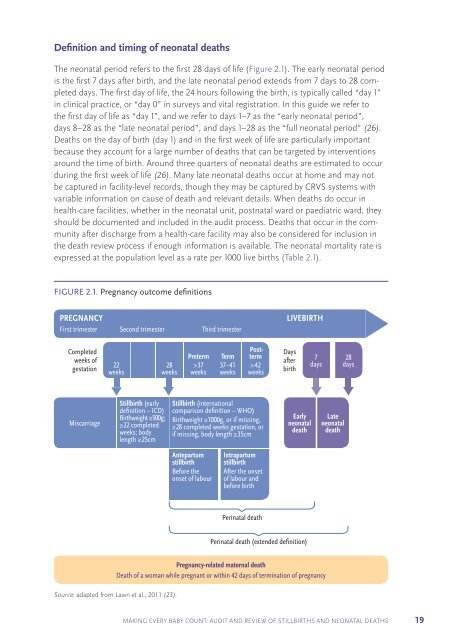Making Every Baby Count
9789241511223-eng
9789241511223-eng
You also want an ePaper? Increase the reach of your titles
YUMPU automatically turns print PDFs into web optimized ePapers that Google loves.
Definition and timing of neonatal deaths<br />
The neonatal period refers to the first 28 days of life (Figure 2.1). The early neonatal period<br />
is the first 7 days after birth, and the late neonatal period extends from 7 days to 28 completed<br />
days. The first day of life, the 24 hours following the birth, is typically called “day 1”<br />
in clinical practice, or “day 0” in surveys and vital registration. In this guide we refer to<br />
the first day of life as “day 1”, and we refer to days 1–7 as the “early neonatal period”,<br />
days 8–28 as the “late neonatal period”, and days 1–28 as the “full neonatal period” (26).<br />
Deaths on the day of birth (day 1) and in the first week of life are particularly important<br />
because they account for a large number of deaths that can be targeted by interventions<br />
around the time of birth. Around three quarters of neonatal deaths are estimated to occur<br />
during the first week of life (26). Many late neonatal deaths occur at home and may not<br />
be captured in facility-level records, though they may be captured by CRVS systems with<br />
variable information on cause of death and relevant details. When deaths do occur in<br />
health-care facilities, whether in the neonatal unit, postnatal ward or paediatric ward, they<br />
should be documented and included in the audit process. Deaths that occur in the community<br />
after discharge from a health-care facility may also be considered for inclusion in<br />
the death review process if enough information is available. The neonatal mortality rate is<br />
expressed at the population level as a rate per 1000 live births (Table 2.1).<br />
FIGURE 2.1. Pregnancy outcome definitions<br />
PREGNANCY<br />
First trimester Second trimester Third trimester<br />
LIVEBIRTH<br />
Completed<br />
weeks of<br />
gestation<br />
22<br />
weeks<br />
28<br />
weeks<br />
Preterm<br />
> 37<br />
weeks<br />
Term<br />
37–41<br />
weeks<br />
Postterm<br />
> 42<br />
weeks<br />
Days<br />
after<br />
birth<br />
7<br />
days<br />
28<br />
days<br />
Miscarriage<br />
Stillbirth (early<br />
definition – ICD)<br />
Birthweight ≥500g;<br />
≥ 22 completed<br />
weeks; body<br />
length ≥ 25cm<br />
Stillbirth (international<br />
comparison definition – WHO)<br />
Birthweight ≥1000g, or if missing,<br />
≥ 28 completed weeks gestation, or<br />
if missing, body length ≥ 35cm<br />
Early<br />
neonatal<br />
death<br />
Late<br />
neonatal<br />
death<br />
Antepartum<br />
stillbirth<br />
Before the<br />
onset of labour<br />
Intrapartum<br />
stillbirth<br />
After the onset<br />
of labour and<br />
before birth<br />
Perinatal death<br />
Perinatal death (extended definition)<br />
Pregnancy-related maternal death<br />
Death of a woman while pregnant or within 42 days of termination of pregnancy<br />
Source: adapted from Lawn et al., 2011 (23).<br />
MAKING EVERY BABY COUNT: AUDIT AND REVIEW OF STILLBIRTHS AND NEONATAL DEATHS<br />
19
















